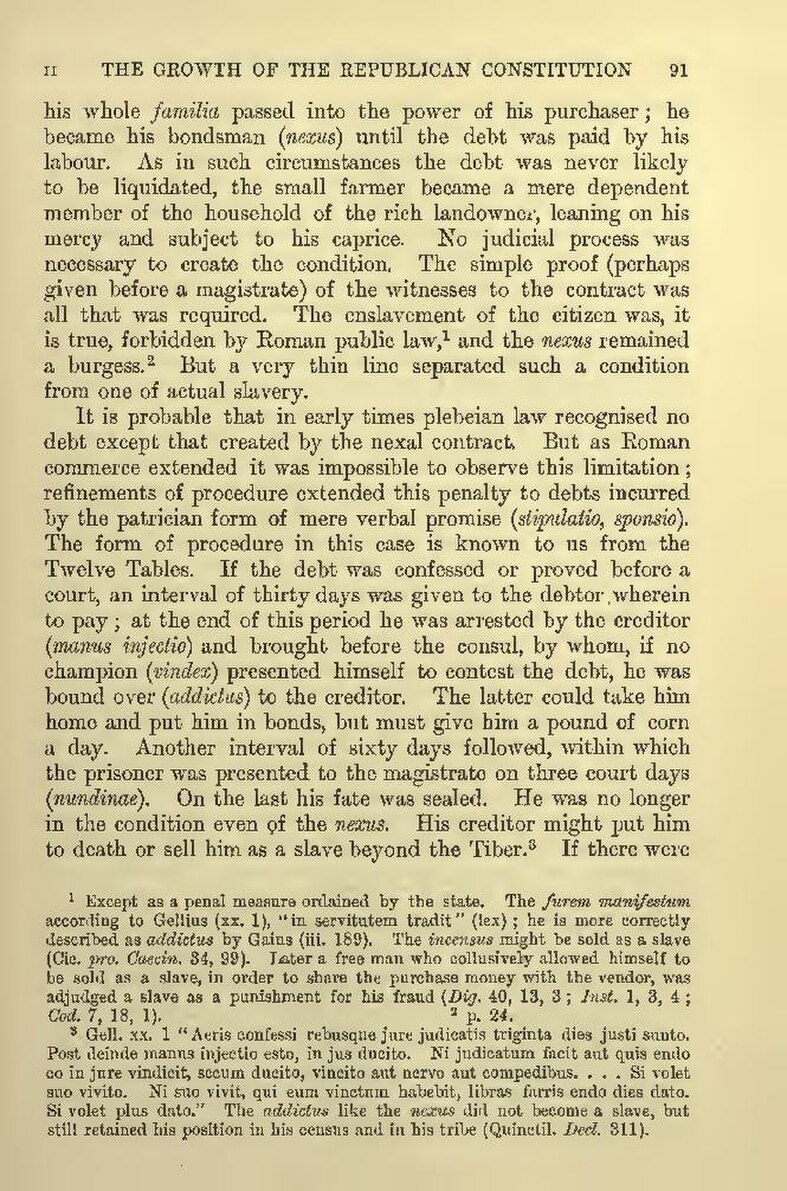his whole familia passed into the power of his purchaser; he became his bondsman (nexus) until the debt was paid by his labour. As in such circumstances the debt was never likely to be liquidated, the small farmer became a mere dependent member of the household of the rich landowner, leaning on his mercy and subject to his caprice. No judicial process was necessary to create the condition. The simple proof (perhaps given before a magistrate) of the witnesses to the contract was all that was required. The enslavement of the citizen was, it is true, forbidden by Roman public law,[1] and the nexus remained a burgess.[2] But a very thin line separated such a condition from one of actual slavery.
It is probable that in early times plebeian law recognised no debt except that created by the nexal contract. But as Roman commerce extended it was impossible to observe this limitation; refinements of procedure extended this penalty to debts incurred by the patrician form of mere verbal promise (stipulatio, sponsio). The form of procedure in this case is known to us from the Twelve Tables. If the debt was confessed or proved before a court, an interval of thirty days was given to the debtor wherein to pay; at the end of this period he was arrested by the creditor (manus injectio) and brought before the consul, by whom, if no champion (vindex) presented himself to contest the debt, he was bound over (addictus) to the creditor. The latter could take him home and put him in bonds, but must give him a pound of corn a day. Another interval of sixty days followed, within which the prisoner was presented to the magistrate on three court days (nundinae). On the last his fate was sealed. He was no longer in the condition even of the nexus. His creditor might put him to death or sell him as a slave beyond the Tiber.[3] If there were
- ↑ Except as a penal measure ordained by the state. The furem manifestum according to Gellius (xx. 1), "in servitutem tradit" (lex); he is more correctly described as addictus by Gaius (iii. 189). The incensus might be sold as a slave (Cic. pro. Caecin. 34, 99). Later a free man who collusively allowed himself to be sold as a slave, in order to share the purchase money with the vendor, was adjudged a slave as a punishment for his fraud (Dig. 40, 13, 3; Inst. 1, 3, 4; Cod. 7, 18, 1).
- ↑ p. 24.
- ↑ Gell. xx. 1 "Aeris confessi rebusque jure judicatis triginta dies justi sunto. Post deinde manus injectio esto, in jus ducito. Ni judicatum facit aut quis endo eo in jure vindicit, secum ducito, vincito aut nervo aut compedibus. . . . Si volet suo vivito. Ni suo vivit, qui eum vinctum habebit, libras farris endo dies dato. Si volet plus dato." The addictus like the nexus did not become a slave, but still retained his position in his census and in his tribe (Quinctil. Decl. 311).
